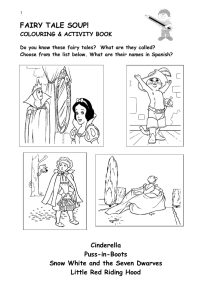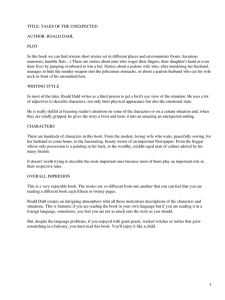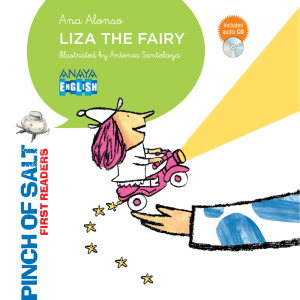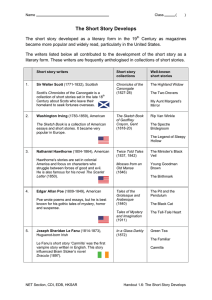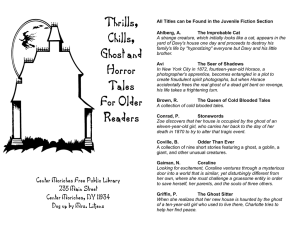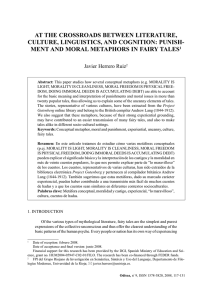Fairy tales, old and new: Barthelme an Coover, two
Anuncio
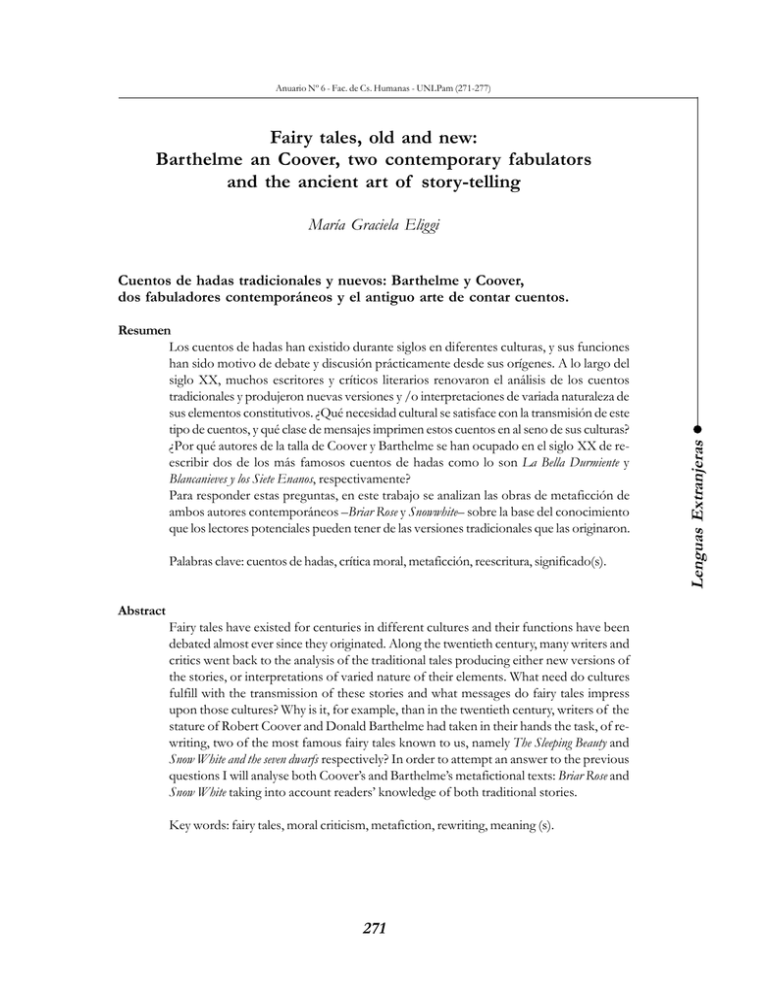
Anuario Nº 6 - Fac. de Cs. Humanas - UNLPam (271-277) Fairy tales, old and new: Barthelme an Coover, two contemporary fabulators and the ancient art of story-telling María Graciela Eliggi Resumen Los cuentos de hadas han existido durante siglos en diferentes culturas, y sus funciones han sido motivo de debate y discusión prácticamente desde sus orígenes. A lo largo del siglo XX, muchos escritores y críticos literarios renovaron el análisis de los cuentos tradicionales y produjeron nuevas versiones y /o interpretaciones de variada naturaleza de sus elementos constitutivos. ¿Qué necesidad cultural se satisface con la transmisión de este tipo de cuentos, y qué clase de mensajes imprimen estos cuentos en al seno de sus culturas? ¿Por qué autores de la talla de Coover y Barthelme se han ocupado en el siglo XX de reescribir dos de los más famosos cuentos de hadas como lo son La Bella Durmiente y Blancanieves y los Siete Enanos, respectivamente? Para responder estas preguntas, en este trabajo se analizan las obras de metaficción de ambos autores contemporáneos –Briar Rose y Snowwhite– sobre la base del conocimiento que los lectores potenciales pueden tener de las versiones tradicionales que las originaron. Palabras clave: cuentos de hadas, crítica moral, metaficción, reescritura, significado(s). Abstract Fairy tales have existed for centuries in different cultures and their functions have been debated almost ever since they originated. Along the twentieth century, many writers and critics went back to the analysis of the traditional tales producing either new versions of the stories, or interpretations of varied nature of their elements. What need do cultures fulfill with the transmission of these stories and what messages do fairy tales impress upon those cultures? Why is it, for example, than in the twentieth century, writers of the stature of Robert Coover and Donald Barthelme had taken in their hands the task, of rewriting, two of the most famous fairy tales known to us, namely The Sleeping Beauty and Snow White and the seven dwarfs respectively? In order to attempt an answer to the previous questions I will analyse both Coover’s and Barthelme’s metafictional texts: Briar Rose and Snow White taking into account readers’ knowledge of both traditional stories. Key words: fairy tales, moral criticism, metafiction, rewriting, meaning (s). 271 Lenguas Extranjeras Cuentos de hadas tradicionales y nuevos: Barthelme y Coover, dos fabuladores contemporáneos y el antiguo arte de contar cuentos. Eliggi, M. G. Anuario Nº 6 - Fac. de Cs. Humanas - UNLPam (271-277) Fairy tales have existed for centuries in different cultures and their functions have been debated almost ever since they originated. At the beginning, people passed them down orally, and later on, they became part of the written tradition. They have been defined by Britannica Encyclopaedia as ‘wonder tales involving marvelous elements and occurrences, though not necessarily about fairies.’ Art fairy tales were cultivated in the period of German Romanticism by Goethe, Brentano, and Hoffmann and in Victorian England by John Ruskin (The King of the Golden River,1851) and Charles Kingsley (The Water-Babies,1863), few of which have found permanent popularity. But, undoubtedly, the master of the art fairy tale, whose works rank with the traditional stories in universal popularity, is the Danish writer Hans Christian Andersen. Though his stories have their roots in folk legend, they are personal in style and contain elements of autobiography and contemporary social satire. The influence of Perrault and the Grimm brothers has also been worthy of note, and their versions have been commonly adopted as part of the Western fairy tale canon. Along the twentieth century, many literary and feminist writers and critics –as well as psychoanalysts– went back to the analysis of the traditional tales producing either new versions of the stories, or interpretations of varied nature of their component elements. Some critics argued that the tales were vivid manifestations of universal fears and desires. Others, such as Bruno Bettelheim in his Uses of Enchantment (1976), asserted that “the apparently cruel and arbitrary nature of many folk fairy stories is actually an instructive reflection of the child’s natural and necessary ‘killing off ’ of successive phases of development and initiation”. What need do cultures fulfill with the transmission of these stories and what messages do fairy tales impress upon those cultures? Why is it, for example, that in the twentieth century, writers of the stature of Robert Coover and Donald Barthelme had taken in their hands the task of re-writing two of the most famous fairy tales known to us, namely The Sleeping Beauty and Snow White and the seven dwarfs, respectively? In order to attempt an answer to the previous questions I will analyze both Coover’s and Barthelme’s texts: Briar Rose and Snow White taking into account readers’ knowledge of both traditional stories. Among the functions generally attached to fairy tales in various cultures we find that of teaching, of passing on moral judgement about what is good and bad, of making clear what is expected from different members of a social group and that of how someone should behave according to their gender. An analysis of Coover’s and Barthelme’s alternative versions of the traditional tales can show both points of contact as well as striking differences related to function. Grimm’s Little Briar Rose (better known by Perrault’s name The Sleeping Beauty) is a story organized in the traditional way following a beginning, middle and end pattern in which the main female character –the little princess– suffers the consequences of her parents’ actions and is cast a spell by the evil fairy which will put an end to her life, later changed by the good fairies to ‘sleep for a 272 hundred years until a prince charming comes to disenchant her.’ The story follows a plan which divides characters into good and evil, and develops along the anticipated lines until the happy ending in which those who are good live happily ever after and those who are bad receive their deserved punishment, stressing the moral aspect of the tale. In Briar Rose, Coover’s version of Little Briar Rose we find a first difference in the length of the text, which rather resembles that of a novel, yet it is not a novel in the ‘proper’ sense. It refuses any attempt to recognize in it the structure of the traditional novel –in the XIX Century sense–, as it does not conform to the teleological forms. Instead, it is arranged as a set of juxtaposed stories, overlapping one another, where characters, though apparently always the same, are constantly changing and undergoing a metamorphic process. The story cannot be said to have a plot but several ones, each of them told from a different point of view: that of the prince, the princess, the crone, the king and the queen and so on and on without end. This technique makes it impossible for the reader to follow a narrative line and try to make sense in the old way, reaching some kind of meaning. On the contrary, the readers are constantly faced with the dilemma of going backwards and forwards to make sure they did not miss something important for their interpretation of the work. Moreover, in successive parts or episodes the point of view of the different characters begins to vary He has undertaken this great adventure, not for the supposed reward... To make at last his name. Coover 1996: 1) Who is he to seek to make his name or to penetrate the inpenetrable? (Coover 1996: 9) Perhaps, he thinks with a shudder, I have not been chosen after all... Perhaps I am not the one. (Coover 1996: 22) Their perspectives are not the same as before as it is shown in the selected excerpt – changes continue until the very end– and this adds to the impossibility of understanding the reality of the text. The reader feels at a loss and wonders whether there is some sort of reality that can be grasped at all. Coover’s story, constructed as a never ending text where each episode or part may lead to multiple interpretations, exemplifies the obvious rejection on the part of the writer to produce a “‘finalized’ event, personality, and morality... [preferring the] construction of open-ended collage-like forms” (Gordon 1983: 3). This presentation of the text as a set of fragments which will never conform to a perfect whole, but that allows to be shuffled and reshuffled endlessly, attempts to dissolve centrality of focus and forces the reader to adopt a creative role organizing the narrative in his/her own way. This can only be achieved if the reader is able to stand all the shifts and variants offered by the text. All this supports the idea expressed by many critics of Coover’s preference for ‘process’; his interest is not placed on the totality of a ‘product’ but “in the perfection of process, flux and possibility” (Gordon 1983: 6). In 273 Lenguas Extranjeras Fairy tales, old and new: Barthelme an Coover, two contemporary fabulators and the ancient art of story-telling Eliggi, M. G. Anuario Nº 6 - Fac. de Cs. Humanas - UNLPam (271-277) his text there are no conclusions and every time it is read it reads differently. Images, characters, and events adopt a transformational nature. This supports Coover’s idea of redifining the concepts of normality and abnormality, presenting the abnormal features of the different elements of the stories as normal (Coover 1996: 10), deconstructing in this way the concept of a fixed identity measurable or observable to the senses “the self gone apart...the departed self ” (Coover 1996: 2) “Who am I? ...What am I?” (p. 17). All absolute standards in the Aristotelian way such as, heroism, courage and responsibility are deconstructed too, and lose their face value. Protagonists face eternal predicaments: how to deal with the need for power, control, personal failure, sexual longings, among others (Coover 1996: 28). Irony and black humour mark great part of the text which is rich in scenes depicting decay and morbidity and full of scatological descriptions (Coover 1996: 6, 47). After countless new beginnings the story of the basic princess/prince relationship, each with diverse outcomes, ends with the ambiguity of the good fairy who is also bad watching the princess’ attempt to kill herself with the spindle trying to get rid of her uncertain life in death and death in life, to go back to sleep. Coover’s, at times macabre, others hilarious version of Little Briar Rose is a typical example of the type of fiction that developed in the sixties, called fabulation, metafiction or surfiction, to give the most common terms, which found delight in the design of literary works as independent from their content, asserting in this way ‘the authority of the shaper of the work of art (Scholes 1980: 2) This writing tendency would also stress the qualities of art and joy and the possibility of teaching through writing in a way that “tends away from direct representation of the surface of reality but returns toward actual human life by way of ethically controlled fantasy (Scholes 1980: 3) This new form of fiction and the process which generates it, has also been called experimental fiction, that which, according to Raymond Federman in his essay “Surfiction: A Postmodern Position” is given the label ‘experimental’ that which is “unusual, difficult, innovative, provocative, intellectualy challenging and even original... a novel is always a form of experiment, and therefore becomes an experience” (Federman 1993: 37). Following both Federman and Scholes we can say that Coover is a true fabulator who delighted in the creation or recreation of an old tale, giving it and innovative, unusual and original shape and allowing the reader to experiment in his/her own ways with the text and make it ‘mean’ way beyond the limitations of the text itself. Donald Barthelme’s work Snow White goes along different lines in his re-working of the traditional tale for children. There is nothing of the stepmother-princess-princedwarfs situation- the characters of the original tale, as in Coover’s text. Barthelme, instead, plays with the name of the story and strikes the reader in the very first page by introducing the female character in an unusual way for a conventional story: the character does not have a name (yet) but we, as readers can speculate that she is an ‘imposing 274 brunette’, from the special letter font used for the pronoun ‘She’. The writer makes the reader engage in the play that has already begun and that will take him/her through different paths. Next, and in coincidence with Federman’s idea of the need to “renew our system of reading” (Federman 1993: 40), he uses graphical devices (dots) to complete the physical description of the character. The last sentence of the first part of the text resembles in a way the description of the traditional Snow White suggesting but not stating that this might be the name of the character. The following episode or part introduces the seven male characters, whose names are common English names, presents Bill as the leader and proceeds with a set of digressions that pinpoint the situation being lived in the house and some of their problems- Bill’s reluctance to be touched and their reactions. The next episode restates the digressive nature of Barthelme’s fiction in which the narrative does not necessarily follow logical transitions and along which there is an ingenious play on words. “Oh I wish there were some words in the world that were not the words I always hear!... Injunctions! Bill said...” (Barthelme 1967: 12). The rest of the elements that complete Part One of the novel continue adding information about the lives of Snow White and her seven lovers who visit her in the shower room, about their uncertainties and feelings of loneliness No one knows what the rest think or feel. There are images of anonymity in a city which is described in one of the episodes by means of an incoherent description where things are just the opposite of what they are supposed to be. “The cars are forced to use the sidewalks, the women walk in the street proper... they have a girl river they don’t use much” (Barthelme 1967: 21) Every five or six episodes we reach parts written in block capital letters with assorted messages: Snow White’s fears and memories, Problems faced by the English Romantics and their ways of solving them, The Religious Revolution of the Past Generation, The History of Horsewives, and others. In one or two of these sections we can establish a connection with the traditional tale since among Snow White fears we read: mirrors, apples and poisoned combs and among her memories: the huntsman, the forest and the steaming knife. Intermingled with this we find references to the baby food Snow White’s men prepare as a second job, the introduction of Jane as the “wicked stepmother” under the appearance of a XX c. competitor “I grow more witchlike as the hazy days imperceptible meld into one another” (Barthelme 1967: 46), Paul as the prince that could ‘complete’ her. The last section is a questionnaire related to the readers understanding and liking of the story so far, connections with the traditional tale, ways of reading and so on, characteristic device of this type of fiction which reflects upon the fiction-making process that involves: writer, medium and reader. Part Two is composed of a number of episodes beginning with the word ‘Perhaps’ which underlies the whole part, again introducing the feeling of lack of certitude typical of a commodified society, the members of which, do not have other better goals than 275 Lenguas Extranjeras Fairy tales, old and new: Barthelme an Coover, two contemporary fabulators and the ancient art of story-telling Eliggi, M. G. Anuario Nº 6 - Fac. de Cs. Humanas - UNLPam (271-277) working and earning money. There is a recurring motif in Snow White’s hair –black as ebony– which is repeated throughout this part causing or rather not causing the expected reactions on those who see it. The last episode of this part relates the hair motif to the drawbacks of technological development in America, the extinction of the buffalo, alienation and sense of displacement; Snow White feels she is in the wrong time and place: the world had not been able to supply either a prince or the correct ending to the story (Barthelme 1967: 138). Part Three begins with a definite ‘Snow White’ written in block capital letters showing her true identity and at the same time her determination to change, her new decisions about their lives. Again she is not certain about the outcomes but she decides to take the risk. Subsequently we have some episodes dealing with lack of leadership and the quality of life in America; comments on the quality of Russian literature and on the politics of the time: lack of belief and expectations, a subtle, still sharp critique of the Establishment: an impersonal force, represented by a President not likely human, a truly foolish being. Interspersed with all these events, we see Snow White and Paul’s relationship ‘undevelop’ at a distance: she undresses in front of the window while she meditates about her body and mind, life values and people worthy of trust: children under eleven. Anger, frustration, dissatisfaction, wrong-doing, disappointment, lack of certainty and hope are the key words that accompany this part of the novel. The trial that involves Bill, parodies the American judicial system and the vacuity of words used to interrogate defendants in a trial. The scene where Snow White’s friends are fined and charged with felony for sitting more than ten feet from the building line and wrinkling a tablecover mocks at the sometimes ridiculous regulation system in force. Snow White’s meditation continues. Jane prepares to poison Snow White out of jealousy. Hogo declares his love to Snow White but is not welcome. Paul, the true frog and fake prince dies, poisoned by Jane, she dies too, drinking her own poison. Characters and their lives get into a turmoil; yet, the novel ends in assertion and a certain degree of hope: to despise and to condemn the world for what it is does not bring about positive changes. Snow White and her new group, Hogo included, reassume the control of their lives. Their relation once based on physical attraction came to an end and a spiritual and virginal stage began; Snow White is considered as a deity and the hero men leave in search of new values. The final ‘heigh-ho’ sound gives a note of hope and strength for the accomplishment of their task. Going back first to the definition of what a fairy tale is we can say that both Coover’s and Barthelme’s texts can fit the definition provided at the beginning, both are wonder tales with marvelous elements and occurrences in their own ways. As regards the reasons that both writers may have had to write their texts I would say that much in the style of Andersen’s, their precursor, they may have been led by the need to mock at or criticize their contemporary society or just to play some sort of writing game which 276 Fairy tales, old and new: Barthelme an Coover, two contemporary fabulators and the ancient art of story-telling includes elements of the reality outside the text. In connection with the functions that traditionally have been attached to fairy tales, even though Coover’s and Barthelme’s intentions may not have been purely didactic or probably they would not admit they were passing judgement, I believe that there was in their ‘incoherent, digressive, circular, devoid of meaning’–and the list of adjectives can go on– writings, the implied need to teach not (emphasis added) ‘what to do’ and ‘how to do it’, but that there are other possibilities to fiction reading and writing that need of an open mind that can make the text ‘be’ instead of just ‘mean’, assuring in this way its own existence. Fuentes Brytannica Encyclopaedia Bibliografía Barthelme, D. (1967). Snow White. New York: Atheneum. Bettelheim, B. (1977). The Uses of Enchantment: The Meaning and Importance of Fairy Tales. New York: Vintage. Coupe, L. (1997). Myth. London and New York: Routledge. Federman, R. (1993). Critifiction. Postmodern Essays. New York: State University of New York Press. Gordon, L. (1983). Robert Coover. The Universal Fictionmaking Process. Carbondale and Evansville: Southern Illinois University Press. Grimm Brothers. (1945). Grimm’s Fairy Tales. Translated by James Stern. New York: Pantheon Books Inc. Scholes, R. (1980). Fabulation and Metafiction. Urbana, Chicago and London: University of Illinois Press. 277 Lenguas Extranjeras Coover, R. (1996). Briar Rose. New York: Grove Press.
